New York City
"By 2030, our City will be getting bigger, our infrastructure older, and our environment more unpredictable. Now is the time for New Yorkers to rise once again to the challenge of tomorrow."
- PlaNYC 2030
| Overview of PlaNYC 2030 |
| Download: Full PLANYC Report (39.46 MB) |
PlaNYC (pronounced PLAN-Y-C) 2030 was launched by Mayor Michael R. Bloomberg on Earth Day 2007 targeting the improvement and preservation of New York City's urban environment for a more sustainable future city. This seemingly comprehensive plan breaks down its efforts into 5 key dimensions or 10 goals for 2030:
| 5 Key Dimensions: | 10 Goals for 2030: |
| (http://www.nyc.gov/html/planyc2030/html/plan/plan.shtml) | (http://www.nyc.gov/html/planyc2030/html/heard/heard.shtml) |
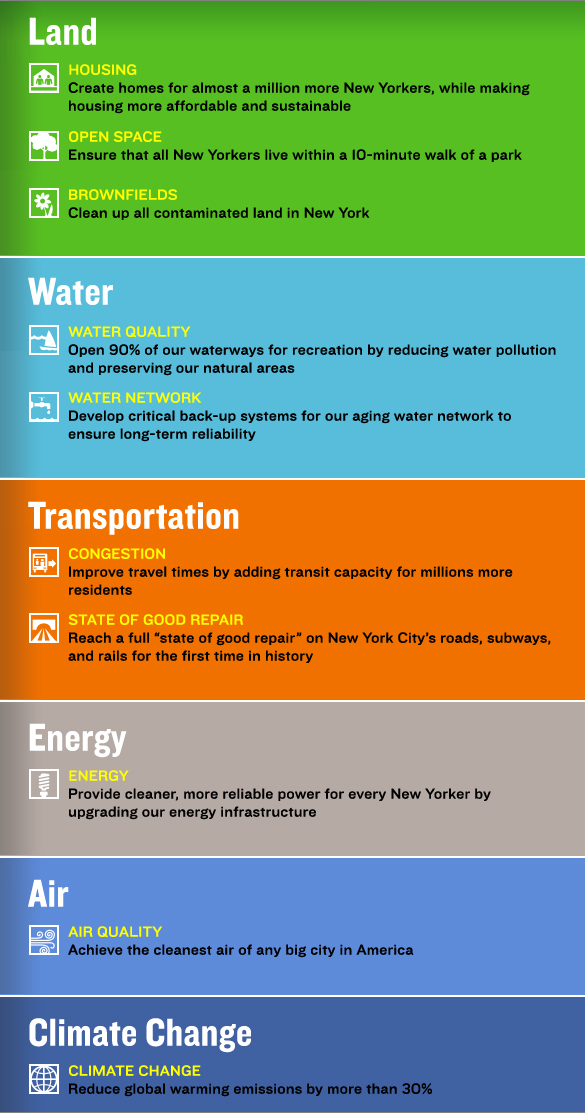 |
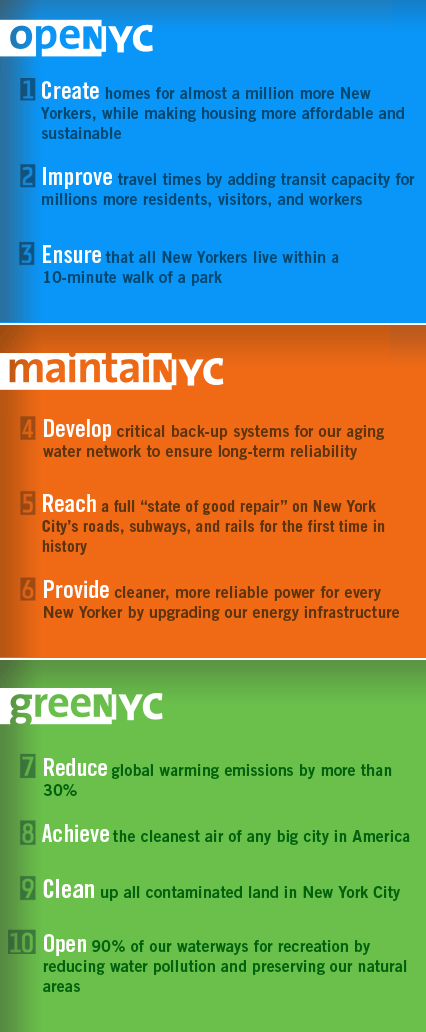 |
|---|
While New York's plan has goals that are not explicitly for the greening of the city, these goals still fall under the larger umbrella of sustainability which includes economic and social sustainability in addition to environmental sustainability. Even so, most of these goals have trickle-down effects that contribute to environmental sustainability. For example, the goal of developing more housing addresses the social need to house a growing population while addressing affordability and sustainable homes. Although not explicitly stated, the provision of housing within the city has larger implications on the overall sustainability of the New York City.
Many theories about the ideal form of sustainable cities exist. Since we are measuring New York City against Portland, this study will favor Portland's strategies. Thus, assuming that sprawl reduces the sustainability of a place through increased land consumption and increased transportation times, retaining residents within the city through housing will prevent sprawl and improve the sustainability of New York City.
A subset of the larger PlaNYC, GreeNYC provides a resource for NYC residents to reduce their collective carbon footprint. GreeNYC provides residents with conservation strategies, advertises for special programs such as the air conditioner exchange program with NYSERDA and provides two videos from the GREENYC TV campaign.
| GreeNYC TV Campaign (http://www.nyc.gov/html/planyc2030/html/greenyc/greenyc.shtml) |
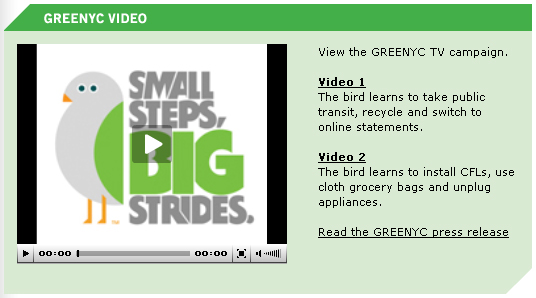 |
Assessing The Plan
PlaNYC is emerging in a very different time period from Portland's plans. The means of idea dissemination and implementation are far more advanced and far-reaching, but perhaps may also be more limited along socioeconomic lines. The media strategies employed by PlaNYC are possibly as advanced as possible for the present day, just as they were in the 1980s for Portland.
Despite the broad goals of PlaNYC, the report details the specific projects that each goal will target. The details are in varying levels of depth, providing different measures for implementation. Some broadly define what needs to be done while others describe projects in varying stages of completion and anticipated next steps. For the purpose of developing concrete plans for action, these areas could be more specific and should subsequently be covered in more depth.
The final pages of the report are devoted to two tables: "Goals" and "Implementation." The report does two important things through these tables:
| Icons used to indicate goals addressed by each initiative | ||
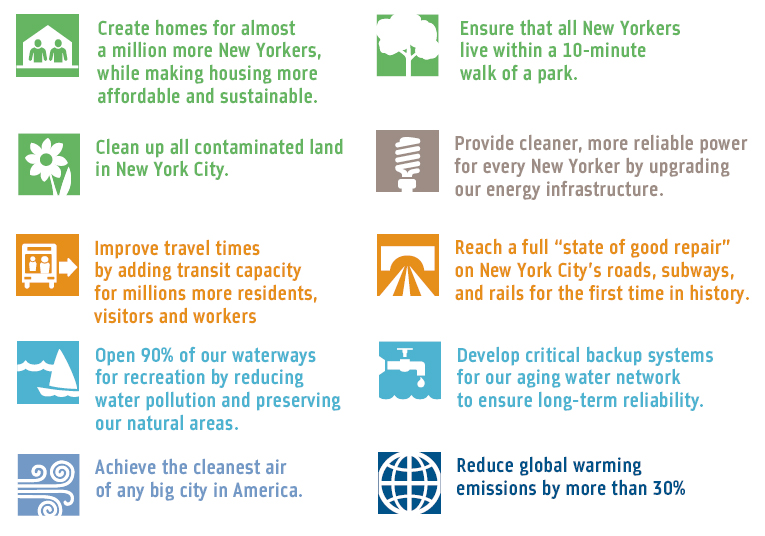 |
||
Planning History & Political Environment
Emerging in a different time period and in a different social and political climate, PlanYC has a very different appeal, design and strategy, some of which raise questions for the eventual success of PlaNYC.
| Circumstance | Questions Raised for Future Plan Success |
| PLANNING HISTORY | |
| Planning in New York City has often been done in broad brushstrokes with large projects like Central Park, Urban Renewal and the transformation of the city under the hands of Robert Moses. Thus, New York City is no stranger to large-scale plans. |
|
| POLITICAL ENVIRONMENT | |
| Strong Private Interests: As a center of commerce with many strong and wealthy interests, politics have often been heavily influenced by the private interests. |
|
| Post 9/11: Since 9/11, the public has been more amenable to stronger government actions for the sake of public safety. |
|
| Corporate Partnerships and Sponsors |
|
| CULTURAL ENVIRONMENT | |
| The imminent issues of global warming are forcing cultural shift. |
|
| Being "green" is trendy. |
|
| Implementation Strategy | Description |
| IDEA DISSEMINATION | |
| Multi-Media Strategy (video, etc.) |
|
| Publicity |
|
| Report Document |
|
| Internet |
|
| PUBLIC PARTICIPATION | |
| Website Commentary |
|
| Townhall Meeting |
|
| Community Leader Comments |
|
CALL TO ACTION |
|
| Challenge to the City |
|
| In anticipation of: |
|
| ACTION STEPS | |
| Practical Goals |
|
| Schedule of Action |
|
| Delegated Responsibility |
|
In the questions raised above, we realize there are many uncertainties as there often are with any plans. Despite the distinct environments of New York City and Portland, perhaps the two cities' attitudes towards sustainability have reached a comparable level in the present day.
Just this past Saturday, November 17, 2007, the Intergovernmental Panel on Climate Change released a report describing the risks of inaction on climate change. With global warming reaching an unprecedented level of recognition and public awareness, this study presumes that the issues of climate change and sustainability are approaching a critical tipping point for the public. As a consequence, even if New Yorkers have not always felt the close link to the natural environment exemplified by Portlanders, politically, any initiative preserving or benefiting the environment may soon be viable if it is not already.
Regarding the larger private interests which are often powerful in this center of commerce, the common good in this arena may finally be strong enough to be considered equivalent. Corporate sponsorship is indicative of a trend in this direction. So, as Portland has always dealt with the public and private interest in an evenhanded way, NYC may have the opportunity act in a comparable way. This paradigm shift presents an unprecedented opportunity, but at the same time warrants caution to avoid shallow initiatives that follow a trend without grappling with the deeper issues of creating a sustainable city and community.
PlaNYC, compared to Portland's Central City Plan, has a superior visual appeal, indicative of the time periods in which each arose. While largely incomparable, the organization of Portland's report was more conducive to understanding each initiative in its entirety. When relying on the website to understand the plan, the nature of a website has scattered the elements of the plan such that what a person gleans from the plan is wholly dependent on each individual's path through the links. As a consequence, it is entirely possible to miss portions of the site. A linear report, which PlaNYC also has, limits such skipping, but since the report document does not seem to be primary means of dissemination, missing portions of the site can pose a problem.
At the same time, the nature of the web is also an advantage for PlaNYC. The website is accessible from many more points by a much larger population. Distributing the plan through the world wide web also limits the creation of paper waste. Planners have also taken advantage of the internet as a medium, using the website to gather comments and suggestions from the public. Public input was more pronounced in this way and perhaps comparable to Portland's inclusion of 10,000 citizen voices in their Central City Plan. Hopefully the efforts to incorporate the public view will help this plan reach fruition instead of being shelved with the next mayor.
Sample of PlaNYC's Media Strategy |
||
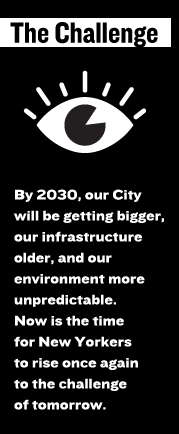 |
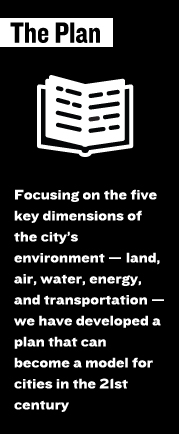 |
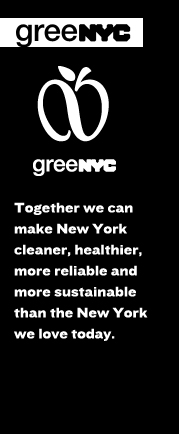 |